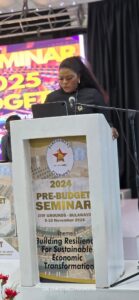SADC INDUSTRIALISATION WEEK IN ZIMBABWE HIGHLIGHTS THE COUNTRY’S ECONOMIC STRUGGLES

The Southern African Development Community (SADC) Industrialisation Week is taking place in Harare, Zimbabwe, from July 28 to August 2, 2024. This event is meant to focus on promoting innovation to unlock opportunities for sustainable economic growth and development. The goal is to work towards an industrialised SADC region. But the situation in Zimbabwe right now tells a very different story.
While the SADC Industrialisation Week is all about driving industrialisation in the region, Zimbabwe itself has been going through a rapid de-industrialisation process. This has caused a lot of economic problems and widespread poverty. According to the United Nations Economic Commission for Africa, no country has managed to lift millions out of poverty without industrialising. So, this is a big concern for Zimbabwe.
The event is being held at the Harare International Conference Centre. It is the largest public-private platform for industrialisation in the SADC region. Countries from the SADC, private sector partners, international organisations, policymakers, researchers, small and medium-sized businesses (SMEs), banks, and civil society groups are all part of this event. They are coming together to share ideas and experiences on how to drive industrialisation and transform the economy.
Throughout the week, the event will have seminars, meetings, workshops, a gala dinner, exhibitions, and visits to some of Zimbabwe’s manufacturing facilities and industrial hubs. The main focus will be on key areas like mineral processing, agro-processing, pharmaceuticals, infrastructure development, women and youth entrepreneurship, and businesses working within the African Continental Free Trade Area.
However, the backdrop of this event is the major decline of Zimbabwe’s industrial sector. Since the year 2000, thousands of companies in Zimbabwe have closed down. Big companies like Anglo American plc, Lonmin Plc, BP, Shell, and Rio Tinto have either left the country or shut down operations. These closures are due to a tough business environment, poor policies, land reforms, indigenisation policies, mismanagement, and corruption.
Back in 1980, Zimbabwe was the second most industrialised country in Sub-Saharan Africa, just behind South Africa. Today, it is one of the poorest economic performers in the region. Zimbabwe has become an example of how not to manage an economy. The agriculture, mining, and manufacturing sectors, which were once the backbone of the Zimbabwean economy, have suffered greatly because of bad government policies. This has led to the near-collapse of these sectors and high unemployment rates.
At present, around 90% of Zimbabweans are unemployed. Many people are surviving by working in the informal sector, which often means selling second-hand clothes or other basic items. Millions of Zimbabweans have left the country, seeking better opportunities in nearby countries like Botswana and South Africa or even further away in places like the United Kingdom, Australia, Canada, and the United States.
By 2015, Zimbabwe’s manufacturing sector had almost completely collapsed. Many companies either shut down or moved away because the economic climate was too harsh. Bulawayo, which used to be Zimbabwe’s industrial hub and was even called “Kontuthuziyathunqa” (the place where smoke billows out of industries), is now filled with churches and other non-manufacturing activities.
The United Nations Economic Commission for Africa says that industrialisation is the surest path to rapid, long-lasting, and sustainable economic development, especially for countries with large populations. They have pointed out that no country has been able to lift millions out of poverty without industrialising. Successful industrialisation is the key to bringing about economic growth and change, something Southern Africa needs badly.
For Southern Africa to industrialise successfully, it must improve its productive capacity, encourage investment in modern industries, build stronger value chains, and deepen opportunities for regional trade. The commission also highlights the need for inclusive and sustainable industrialisation. This means addressing infrastructure problems, adopting sound economic policies, promoting technological learning, and using traditional revenue streams to build an export-driven manufacturing sector.
As SADC Industrialisation Week continues in Harare, the contrast between the event’s goals and the state of Zimbabwe’s economy highlights the many challenges the region still faces.

